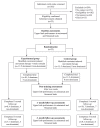Influences of hand dominance on the maintenance of benefits after home-based modified constraint-induced movement therapy in individuals with stroke
- PMID: 25372006
- PMCID: PMC4228629
- DOI: 10.1590/bjpt-rbf.2014.0050
Influences of hand dominance on the maintenance of benefits after home-based modified constraint-induced movement therapy in individuals with stroke
Abstract
Objective: To investigate the influence of hand dominance on the maintenance of gains after home-based modified constraint-induced movement therapy (mCIMT).
Method: Aprevious randomized controlled trial was conducted to examine the addition of trunk restraint to the mCIMT. Twenty-two chronic stroke survivors with mild to moderate motor impairments received individual home-based mCIMT with or without trunk restraints, five times per week, three hours daily over two weeks. In this study, the participants were separated into dominant group, which had their paretic upper limb as dominant before the stroke (n=8), and non-dominant group (n=14) for analyses. The ability to perform unimanual tasks was measured by the Wolf Motor Function Test (WMFT) and the Motor Activity Log (MAL), whereas the capacity to perform bimanual tasks was measured using the Bilateral Activity Assessment Scale (BAAS).
Results: Analysis revealed significant positive effects on the MAL amount of use and quality of the movement scales, as well as on the BAAS scores after intervention, with no differences between groups. Both groups maintained the bimanual improvements during follow-ups (BAAS-seconds 0.1, 95% CI -10.0 to 10.0), however only the dominant group maintained the unilateral improvements (MAL-amount of use: 1.5, 95% CI 0.7 to 2.3; MAL-quality: 1.3, 95% CI 0.5 to 2.1).
Conclusions: Upper limb dominance did not interfere with the acquisition of upper limb skills after mCIMT. However, the participants whose paretic upper limb was dominant demonstrated better abilities to maintain the unilateral gains. The bilateral improvements were maintained, regardless of upper limb dominance.
Figures
Similar articles
-
Addition of trunk restraint to home-based modified constraint-induced movement therapy does not bring additional benefits in chronic stroke individuals with mild and moderate upper limb impairments: A pilot randomized controlled trial.NeuroRehabilitation. 2014;35(3):391-404. doi: 10.3233/NRE-141130. NeuroRehabilitation. 2014. PMID: 25227543 Clinical Trial.
-
Modified Constraint-Induced Movement Therapy is a feasible and potentially useful addition to the Community Rehabilitation tool kit after stroke: A pilot randomised control trial.Aust Occup Ther J. 2018 Dec;65(6):503-511. doi: 10.1111/1440-1630.12488. Epub 2018 Jun 19. Aust Occup Ther J. 2018. PMID: 29920688 Clinical Trial.
-
Effects of modified constraint-induced movement therapy with trunk restraint in early stroke patients: A single-blinded, randomized, controlled, pilot trial.NeuroRehabilitation. 2018;42(1):29-35. doi: 10.3233/NRE-172176. NeuroRehabilitation. 2018. PMID: 29400671 Clinical Trial.
-
Comparing Ways to Treat Arm Weakness Due to Stroke [Internet].Washington (DC): Patient-Centered Outcomes Research Institute (PCORI); 2021 May. Washington (DC): Patient-Centered Outcomes Research Institute (PCORI); 2021 May. PMID: 38556969 Free Books & Documents. Review.
-
Effectiveness of constraint-induced movement therapy (CIMT)-Telerehabilitation compared to traditional CIMT on upper extremity dysfunction of adult chronic stroke patients-A systematic review and meta-analysis.Physiother Res Int. 2024 Jul;29(3):e2090. doi: 10.1002/pri.2090. Physiother Res Int. 2024. PMID: 38685678
Cited by
-
Progress in the clinical application of constraint-induced therapy following stroke since 2014.Front Neurol. 2023 May 19;14:1170420. doi: 10.3389/fneur.2023.1170420. eCollection 2023. Front Neurol. 2023. PMID: 37273704 Free PMC article. Review.
-
The Effect of Trunk Stability Training Based on Visual Feedback on Trunk Stability, Balance, and Upper Limb Function in Stroke Patients: A Randomized Control Trial.Healthcare (Basel). 2021 May 2;9(5):532. doi: 10.3390/healthcare9050532. Healthcare (Basel). 2021. PMID: 34063280 Free PMC article.
-
The Effects of Proprioceptive Neuromuscular Facilitation Pattern Kinesio Taping on Arm Swing, Balance, and Gait Parameters among Chronic Stroke Patients: A Randomized Controlled Trial.Life (Basel). 2024 Feb 8;14(2):242. doi: 10.3390/life14020242. Life (Basel). 2024. PMID: 38398751 Free PMC article.
-
Deficits in motor coordination of the paretic lower limb limit the ability to immediately increase walking speed in individuals with chronic stroke.Braz J Phys Ther. 2020 Nov-Dec;24(6):496-502. doi: 10.1016/j.bjpt.2019.09.001. Epub 2019 Sep 18. Braz J Phys Ther. 2020. PMID: 31561961 Free PMC article.
-
Mediating Effect of Upper Limb Use on the Relationship Between Upper Limb Performance and Activities of Daily Living: A Longitudinal Mediation Analysis.Cureus. 2022 Oct 29;14(10):e30849. doi: 10.7759/cureus.30849. eCollection 2022 Oct. Cureus. 2022. PMID: 36465773 Free PMC article.
References
-
- Roger VL, Go AS, Lloyd-Jones DM, Benjamin EJ, Berry JD, Borden WB, et al. Heart disease and stroke statistics-2012 update: a report from the American Heart Association. Circulation. 2012;125(1):e2–220. http://dx.doi.org/10.1161/CIR.0b013e31823ac046 - DOI - PMC - PubMed
-
- Kitago T, Liang J, Huang VS, Hayes S, Simon P, Tenteromano L, et al. Improvement after constraint-induced movement therapy: recovery of normal motor control or task-specific compensation? Neurorehabil Neural Repair. 2013;27(2):99–109. http://dx.doi.org/10.1177/1545968312452631 - DOI - PubMed
-
- Feys H, De Weerdt W, Nuyens G, van de Winckel A, Selz B, Kiekens C. Predicting motor recovery of the upper limb after stroke rehabilitation: value of a clinical examination. Physiother Res Int. 2000;5(1):1–18. http:// dx.doi.org/10.1002/pri.180 - DOI - PubMed
-
- Taub E, Miller NE, Novack TA, Cook EW 3rd, Fleming WC, Nepomuceno CS, et al. Technique to improve chronic motor deficit after stroke. Arch Phys Med Rehabil. 1993;74(4):347–354. - PubMed
-
- Nascimento LR, Gloria AE, Habib ES. Effects of constraint-induced movement therapy as a rehabilitation strategy for the affected upper limb of children with hemiparesis: Systematic review of the literature. Rev Bras Fisioter. 2009;13(2):97–102. http://dx.doi.org/10.1590/ S1413-35552009005000022 - DOI
Publication types
MeSH terms
Associated data
LinkOut - more resources
Full Text Sources
Medical
Research Materials

